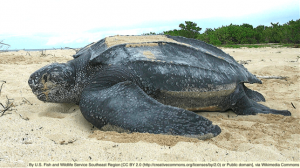Every year, many species travel thousands of miles on a journey called migration. Migration is the process by which a species travels from one habitat to another. Animals may migrate thousands of miles due seasonal changes and or to mate, feed and raise their young.
Let’s look at a few migratory species and learn a bit more about them!

Individuals from this species start off their lives as hatchlings on tropical beaches. If they can make the treacherous journey to the ocean, they will spend the next few years avoiding predators and growing larger. Only just above 5% of hatchlings will make it to their first birthday. Scientists have collected very little information on sea turtles’ lifestyle over their first juvenile years (deemed the lost years) however, they likely hide in algal floats and feed on small prey.
Eventually, these turtles can grow up to six feet long and weight over a thousand pounds. Once females are mature, they will return to the tropics to lay their eggs. They don’t lay their eggs just anywhere though- they actually return to the beach that they themselves hatched on! Males spend their entire lives in the ocean, but females will migrate back and forth from feeding to nesting grounds. This journey can exceed 10,000 miles stretching from tropical beaches in places such as Indonesia up to coastal regions including the pacific coast of North America.
We still don’t know exactly how these animals navigate, but they may use the sun or the Earth’s magnetic field. This species has had quite a bit of time to evolve such amazing navigational prowess. Close relatives of the leatherback have existed for over 100 million years!

The gray whale migrates farther than any other mammal known to date. In total, this whale travels up to 12,000 miles every year. These whales give birth in tropical waters largely off of Baja California, Mexico. The warm waters provide shelter for their calves keeping them safe from orcas and allowing them to put on blubber. The babies grow quickly eating an average of fifty gallons of milk every day. Over this time, the mother eats little to nothing and looses much of her body mass.
After 2-3 months, the whales begin migrating northward in groups called pods. Their destination is the artic waters of the Bering and Chukchi seas. Once they reach these waters, the whales feast. Gray whales are baleen feeders, which means that they have big toothbrush-like baleen plates instead of teeth. They use these plates to scoop up sediment from the bottom of the ocean and filter out plankton, namely krill. These whales can grow up to 50 feet long and weight 50 tons so they need to eat a lot of food!

Here on Catalina, we are within the route of the monarch butterfly’s migration. These amazing butterflies migrate up to 3,000 miles every year. Although the migration contains an entirely new generation of butterflies each year, they still nest on exactly the same trees as their predecessors. We carefully moved these to a homemade habitat and watched as they turned into butterflies. What amazing creatures!
Many animals migrate each through their own remarkable processes. However, climate change is challenging these ancient journeys. Global warming has already begun disrupting migration patterns and will only continue to do so unless species can adapt to the changing climate.
For more:
Migration corridors: http://www.nature.com/news/2011/110622/full/news.2011.379.html
Species changing migration routes and migrating to new areas due climate change: https://www.neefusa.org/weather-and-climate/marine-species-move
For teachers: lesson on migration:
- https://www.nationalgeographic.org/activity/why-animals-migrate/
- https://www.nationalgeographic.org/activity/marine-migration/
http://www.nationalgeographic.com/animals/reptiles/l/leatherback-sea-turtle/
http://www.seeturtles.org/sea-turtle-migration/
https://oceantoday.noaa.gov/graywhalemigration/
http://www.nationalgeographic.com/animals/mammals/g/gray-whale/
http://www.monarch-butterfly.com/monarch-migration.html
https://monarchlab.org/biology-and-research/biology-and-natural-history/migration/
Written by: Talia Niederman


